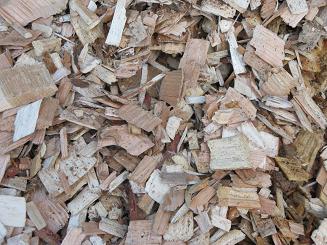S. Ashton, B. Jackson, and R. Schroeder
For the most part, woody biomass for energy is harvested, pre-processed, transported, and utilized all within several days. However, there is still a need for storage capability, for example when demand exceeds supply, during holidays, or when inclement weather prevents harvesting or chipping operations from occurring (Rupar and Sanati, 2004). Prudent storage of biomass harvested during periods of excess production and delivery of this wood when demand exceeds supply is one solution for ensuring a reliable, continuous supply of feedstock.
Storing Logging Residues
There are several ways to store woody biomass. The first is immediately after harvest on-site. There are several advantages to storing unconsolidated woody biomass immediately after harvest. When stored unconsolidated, in mound-like piles of moderate size, leaves and needles are allowed to fall, thus reducing the material’s ash content (Richardson and others 2002). Moreover, when woody biomass is stored in smaller piles, transpirational drying occurs (moisture escapes through leaves and other open wood surfaces). This process lowers the moisture content and fosters the desired outcome of “the drier the material, the higher the heating value.” Additionally, when stored on the harvesting site, vital nutrients are released back into the soil. The major disadvantages to storing woody biomass immediately after harvest on-site are 1) the need for detailed inventory tracking, 2) the cost of forgoing reforestation until the piles of biomass have been removed, and 3) the cost and time-sensitivity of having a contractor return to the site to collect, pre-process, and transport the material to the wood-using facility.
Logging Residue Storage Tips (Fuller 1985)
- Construct piles such that they are mound shaped and not too tall.
- Construct piles no larger than 10ft wide at base and no taller than 6.5 ft.
- Locate piles in an open, well-ventilated place such that wind and sun can help dry the material.
- Locate piles on the harvested site so that nutrients from needles and foliage can be returned back to the soil.
- Stack residue at right angles to the direction of prevailing wind.
- Cover pile with reinforced paperboard to protect from rain and snow.
Storing Processed Material
Mills and other wood-using facilities keep chip or sawdust piles on-site or at nearby facilities for periods when supply is low. The ideal storage period is determined by each facility’s woody supply situation, but typically varies between two and six weeks3. Woody biomass is reduced in size in the forest and then transported for storage, or it is transported, reduced in size at the mill, and then stored. The resulting material, usually chips, is stored outside in large piles and under cover in large silos or bins. Chips stored in bins are typically to be used within several hours or days while silos are used for longer-term storage needs. Silos and bins protect against contamination while at the same time allowing for uniform feeding and metering of the material.
While storing comminuted biomass makes handling and transport relatively easy, if not managed carefully, the biomass will succumb to Dry-matter Loss and in some cases Self-ignition. High temperatures and acetic acid odor are signs that a chip pile is in danger of dry-matter loss and self-igniting. Additionally, chip piles with excessive mold and fungi growth can lead to Health Risks for Humans.
Chipped Material Storage Tips (Fuller 1985)
- Maintain pile height below 50 ft.
- Restrict tractor spreading of just-delivered chips to a minimum.
- Mix species of different deterioration rates only as needed, especially fast-deteriorating hardwoods and full-tree chips.
- Store dirty or full-tree chips, which contain bark and foliage in piles less than 25 ft high, and for less than 2-4 weeks.
- Avoid mixing fine particles (sawdust, shavings, and chip fines) in chip piles, particularly where layering can occur.
- Monitor pile temperature routinely.
Storing Composite Residue Logs
Woody biomass can be bundled and stored under cover to gain the advantages (ease of handling and transport) that come along with storing chipped material. At the same time this approach protects the material from the disadvantages that come along with chipped material, those being dry matter loss, moisture retention, heat generation, and health hazards. Logging residues should be allowed to dry during the summer months before being bundled and stored.
Storage of woody biomass in various forms offers a solution to issues at the end-user location when demand exceeds supply, ensuring a continuous, year-round supply of feedstock. The most common form of storage in the Southeast is chip-pile storage. Shortening the storage time of chipped material will minimize the risk of chemical or microbial decomposition thus minimizing the risk of dry-matter loss, heat generation, and health risks.
References
- Fuller WS. 1985. Chip pile storage: a review of practices to avoid deterioration and economic losses. Tappi. 68(8): 48-51.
- Richardson J, Bjorheden R, Hakkila P, Lowe AT, Smith CT. 2002. Bioenergy from sustainable forestry: guiding principles and practice. Dordrecht, The Netherlands: Kluwer Academic Publishers. 344 p.
- Rupar K, Sanati M. 2004. The release of terpenes during storage of biomass. Biomass and Bioenergy. 28(1): 29-34.
